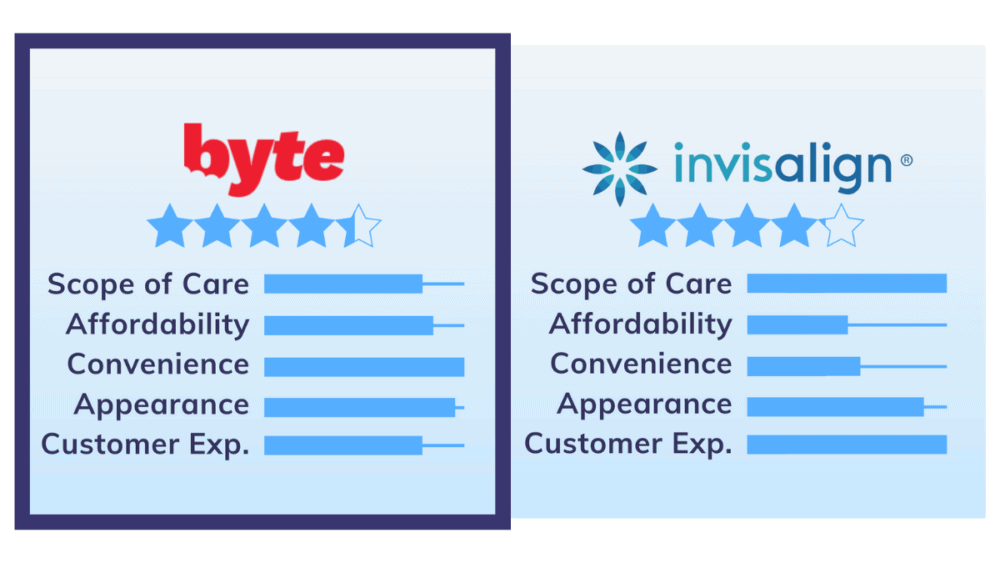
Invisalign took the orthodontic industry by storm in 1997 when they introduced the first-ever clear aligners (aka “invisible braces”). No longer did adults need to fill their mouths with metal to achieve straighter teeth. As their popularity grew, an entire field of clear aligner companies followed, and this competition drove evolution.
Byte is one of the largest at-home aligner brands on the market — one that has incorporated new developments in clear aligner technology. At first glance, Byte might seem similar to Invisalign, but their processes are actually quite different. This review will dig into the details of how Invisalign and Byte actually compare.
Table of Contents
Our Review Methodology
Smile Prep’s reviews are prepared and presented from the perspective of a well-informed consumer. Our starting point for all of our reviews is a careful survey of a company’s marketing claims and available third party customer reviews. We rely on the accuracy of company claims and do not independently verify them. Our reviews use this information to help our readers get information about the available options in a centralized location. You can learn more about our review process by checking out our publishing principles.
Invisalign vs. Byte: At a Glance
Byte and Invisalign both make reputable clear aligner treatments, but that’s about where the similarities end. These are two very different options, each best-suited to different cases.
| Invisalign | Byte | |
|---|---|---|
| Price | $3,000–$8,000 on average | All-Day: $2,099 At-Night: $2,499 |
| Treatment Scope | Mild to severe misalignments, including bite issues | Mild and moderate misalignments, only mild bite issues |
| Average Treatment Plan Length | 12–24 months | Standard: 4–5 months Nighttime: 5–6 months (As advertised) |
| Oversight | Office visits every 4–10 weeks on average | Virtual check-ins recommended, but not required |
| Startup Options | In-person exam and scan | Impression kit |
| Financing | Depends on the provider | CareCredit, All-Day: $0 down, $89/month for 36 months CareCredit, At-Night: $0 down, $106/month for 36 months |
| Nighttime Option | No | Yes |
Our Recommendation
If you have a severe misalignment or bite issue, or you’d prefer to see a dentist in person, Invisalign is probably your best bet. It’ll provide the robust oversight, powerful treatment, and in-person care you need.
Otherwise, we think it’s tough to beat Byte, and we’d recommend their treatment for most readers with mild or moderate cases.
Here's Why We Love Byte
- More Affordable: At $2,099, Byte rings up at thousands less than Invisalign treatment.
- The HyperByte Device: Byte says their high-frequency vibration device, the HyperByte, may reduce discomfort. According to certain studies, devices like this might also encourage faster dental shifts for some. Byte includes the HyperByte in the cost of every treatment plan (per review conducted by our non-clinical team).
- Satisfaction Guarantee: Byte treatment comes with a lifetime warranty on your smile. Once you’ve completed treatment, their Byte for Life Guarantee promises that if your teeth ever shift back, they’ll realign your smile free of charge (as long as you continue purchasing one set of retainers per year).
Is Byte Right for You?
If you decide Byte is the right treatment option for you, be sure to take advantage of this special promotion. Byte is currently offering its impression kit for just $17.95 ($80 off its list price). In addition, as part of this offer Byte will include with your impression kit a free whitening pen to help you brighten your teeth on the go. Enter the code SMILEBRYTE at checkout to claim this promotion.
Before you choose, visit your dentist.
No one knows your teeth better than your dentist, and they’ll know which treatment will work best for you. That’s why we recommend consulting them before deciding. They’ll examine your teeth and take X-rays to make sure your mouth is healthy enough for clear aligners — letting you know if you have any cavities, gingivitis, or under-the-surface issues to address before treatment.
Now, let’s dive in.
Company Overviews
Over two decades ago, a dental technology company called Align Technology developed Invisalign — the first mass-market clear aligner treatment. Invisalign dominated the clear aligner market for nearly ten years. They partnered with dentists and orthodontists across the country, and had transformed 175,000 smiles by 2004. Today, Invisalign maintains its position atop the clear aligner industry. They partner with 100,000 dentists in 90 countries and have treated over 15 million patients.
Founded in 2018, Byte hasn’t treated nearly as many patients, but they’ve become an innovator for at-home aligner treatment. Co-founder and Chief Cosmetic Dentist Dr. Jon Marashi has a star-studded portfolio of A-list patients, but started Byte to help deliver clear aligner treatment to people’s homes. They made waves right away, and we think they’ve quickly become one of the industry’s top competitors, taking the #1 spot in our guide to the best at-home aligners.
Scope of Treatment Comparison
We think Invisalign and Byte are both excellent aligner systems, and between the two, they’ve straightened millions of smiles. But that doesn’t mean either will work for you. To benefit from any aligner system, it must be capable of correcting your misalignment. Although the two companies have some overlap, in the end, Invisalign has a much wider treatment scope.
Invisalign Treatment Scope
Byte Treatment Scope
- Treats all classes of malocclusions, including many skeletal components.
- Can move all of the teeth, including the molars.
- In-person check-ins are usually required every 4–10 weeks.
- Treats mild-to-moderate cosmetic concerns.
- Can’t move the molars.
- Monthly photo check-ins are suggested, but not required.
What Invisalign and Byte Can Treat
Developed to compete with traditional metal braces, Invisalign has one of the widest treatment scopes on the market. According to the company, their aligners have “demonstrated success in treating Class I, II, and III malocclusions,” including:
According to Byte’s website, their aligners can treat:
- Mild-to-moderate crowding
- Mild-to-moderate spacing
- Some cases of overbite
- Some midline misalignment cases
As you can see, Byte treats fewer types of misalignments than Invisalign, and it is also more limited in the severity it can tackle. Yet there’s also the matter of which teeth each system can move.
Invisalign has the power to move all the teeth — molars included. Depending on all the variables in a case, it can even shift the jawbone. This increased treatment scope comes primarily from the use of attachments, which can improve orthodontic dental shifts, making it possible for Invisalign to treat more complex issues.
Byte is like most at-home aligner companies: they focus their treatment on the front 6–8 teeth of either arch. In limited cases, they can move other teeth, but don’t expect their aligners to cover or move the molars.
What Invisalign and Byte Customers Say
Invisalign is the most prolific clear aligner provider on the market, with over 15 million patients to date. That means there are a lot of reviews out there, including many patients who have shared their experiences with us. Based on their feedback, there is little Invisalign can’t treat. Users have shown us their results for everything from simple crowding to complex bite issues and midline misalignments. Almost across the board, they give the treatment 4 or 5 stars.
We’ve also gotten plenty of customer reviews for Byte. Most customers said they got treatment for crowding, spacing, and dental overbites. A few addressed more complex problems, like crossbites and underbites, but these conditions often involve skeletal issues, so they aren’t so common. Patients who use Byte for simpler cases tend to give it 4 and 5 stars at higher rates than those who tried to address more complex ones.
Clinical Oversight
In-office aligners offer hands-on treatment with direct, in-person oversight. Invisalign providers usually have their patients come in for checkups every 4–10 weeks. During these visits, your doctor can apply or modify attachments, adjust your treatment schedule, and catch problems before they can derail your results. Typically simple cases will require less frequent office visits than complex ones.
Byte offers virtual check-ins using the My Byte app, where you’ll upload photos of your teeth for feedback. However, they are only required for cases the company feels need extra oversight. Even if they don’t require it, you can choose to check in once a month just to feel a bit more confident in the process.
Quality of Materials
SmartTrack plastic is Invisalign’s proprietary material and is BPA-free. It is designed, per Invisalign, to provide more predictable treatment outcomes.
Byte doesn’t disclose the specifics of its plastic. However, in 2020, it was acquired by Dentsply Sirona. This is an established and respected company known for its dental products, so we feel confident that Byte uses quality materials.
Affordability Comparison
Straight teeth are great, but not at the expense of your financial well-being. Orthodontic treatments have long presented a significant monetary investment, Invisalign included. But by eliminating the need for office visits, at-home aligner companies have cut their costs nearly in half, making it much more accessible to transform your smile. Even though Invisalign can treat a much wider range of conditions, home aligners like Byte are more suitable for anyone who’s on a tight budget.
Invisalign Affordability
Byte Affordability
- No set sticker price, average cost is $3,000–$8,000.
- Aftercare retainers cost anywhere from $100–$400, depending on the dentist.
- Financing varies depending on the dentist, but may require a credit check or down payment.
- $2,099 sticker price (or $2,499 for Byte At-Night).
- They include one set of aftercare retainers in the cost of treatment.
- CareCredit financing requires a credit check, but no down payment.
Sticker Price
Byte costs $2,099 for All-Day treatment and $2,499 for their nighttime-only aligners. They aren’t the cheapest option out there, but compared to Invisalign, they’re much more cost-effective. Plus, this price includes one set of aftercare retainers. This is a nice touch considering other companies charge you around $100 for retainers.
Trying to pin down Invisalign’s price is harder because it varies depending on your specific dentist and the severity of your condition. Generally, the more office visits you require, the more your treatment will cost. But even at its most affordable, Invisalign is still pricier than home aligners. The average course of Invisalign treatment costs between $3,000 and $8,000. Unique circumstances might cause the price to fall outside this range, but in general, that’s what you can expect to pay.
What About Insurance?
Insurance companies will sometimes consider orthodontic treatment purely cosmetic, especially in milder cases often associated with home aligners. But, that’s not always the case. Whether you choose Invisalign or Byte, there’s a chance you may get some assistance from your insurer — although they’re more likely to cover an in-office treatment like Invisalign.
Rarely will an insurance company cover the entire treatment, but some will contribute to part of the costs, which still helps to make treatment more affordable.
However, Invisalign and Byte’s insurance processes are slightly different. Your dentist or orthodontist’s office can receive payments directly from your insurance company. Byte might not accept payments directly from your insurer, but they will help you submit the forms necessary for reimbursement. They even have partnerships with a few insurance providers, including:
If you get insurance through one of these companies, it doesn’t mean you’ll automatically receive coverage, but it might be easier.
Financing Options
Neither company expects you to have stacks of cash lying around, so you can get financing and payment plans with either.
Invisalign doesn’t have company-wide financing policies. Instead, you’ll need to speak with your dentist about their payment plan options, which may or may not require a credit check and/or down payment.
Byte’s financing plan through CareCredit requires a credit check. For Byte’s standard All-Day aligners, you’ll pay $89/month for 36 months, plus interest. Byte At-Night (see the Convenience section) is slightly more expensive at 36 monthly payments of $106. There is no down payment required for either All-Day or At-Night aligners when financed through CareCredit. You can choose to make a down payment if you would like, however.
Retainers
After any orthodontic treatment, you’ll need to wear retainers for the rest of your life to keep your teeth from shifting back — first all day long, then just overnight. Both companies make clear retainers you’ll need to replace every 6–12 months, on average.
As we mentioned, Byte includes one set for free, but charges $140 for every replacement. However, the Byte Protection Plan provides five years’ worth of retainers for $799. Instead of placing individual orders twice per year, Byte will ship your replacements automatically. You’ll get ten sets in total, so you’ll pay around $80 per set instead of $140.
Invisalign makes a brand of retainers called Vivera, and you can typically get them from your same provider. They come in sets of four and often cost $100–$400 per retainer. According to Invisalign, Vivera retainers are “30% stronger and twice as durable as other leading clear retainer materials,” so you might not need to replace them as often.
Convenience Comparison
Between work, family, friends, and (hopefully) some time for self-care, most adults are pretty busy. So when you find a small window of free time, your top priority probably isn’t to spend it at the dentist’s office. If you ask us, that’s not as convenient as having your aligners delivered directly to your doorstep.
But office visits alone don’t dictate a treatment’s convenience. You should also consider average treatment times, startup processes, schedule flexibility, and more.
Invisalign Convenience
Byte Convenience
- In-person consultation with a dentist is required to get started, including X-rays and photos.
- Requires monthly office visits to monitor progress and receive new aligner sets.
- Average treatment plan is 12–18 months.
- Does not have a nighttime-only option, only the all-day, 22+ hour schedule.
- Ordering an impression kit online is the only way to get started.
- Treatment is completed entirely at home — no office visits required.
- Byte claims their average treatment plan length is 4–5 months for standard treatment and 5–6 months for nighttime-only treatment.
- Offers a nighttime-only option (Byte At-Night) that only requires aligner wear for ten hours per day.
Getting Started
Before kicking off your treatment, Byte needs to confirm that their aligners can deliver the results you’re after. To do so, they will need to get a look at your teeth. This means creating and submitting molds called “impressions.” Your first step will be purchasing and completing an impression kit. The issue is that most people have no experience taking dental impressions. So, this process can be cumbersome, and some customers report needing multiple attempts.
Some people might prefer having everything delivered to their home, but we think Invisalign’s startup process is easier for anyone who’s intimidated by making molds of their teeth. The first step is scheduling a consultation with your provider of choice. Here, you can learn more about your options and a dental professional will take X-rays and scans of your teeth. While we are not dental professionals, our team reviewed certain studies suggesting intraoral scans can be more accurate than conventional impressions — especially impressions taken at home.
The Office Visit Trade-Off
Invisalign’s office visits serve an important purpose. They allow your dentist to oversee and modify your treatment. But when you finally get some well-earned free time, spending it at the dentist’s office isn’t nearly as exciting or relaxing as the alternatives. That’s why many adults opt for at-home companies instead.
After you’re approved for Byte treatment, the company’s dentists will design, produce, and ship your aligners directly to your home. You will need to administer the treatment yourself, but it eliminates the need for regular office visits.
How Long Does Treatment Take?
Byte advertises an average treatment plan length of just 4–5 months. If you choose Byte At-Night, they say the average treatment plan is 5–6 months instead, since you’re wearing your aligners for fewer hours per day.
This is often because Byte is used to treat milder conditions that don’t take as long to correct. Invisalign, on the other hand, treats fairly complex cases, ones that require more drastic or intricate movements. So, Invisalign usually takes 12–18 months, though your treatment time can be longer or shorter, depending on the severity of your condition.
What About Nighttime-Only Treatment?
Nighttime aligners are a relatively new development in clear aligner treatment. Typically, you must wear your aligners for 22+ hours per day to ensure a successful treatment. However, Byte also offers a nighttime-only option, which only requires you to wear your aligners for ten hours per day (overnight) instead.
Byte At-Night aligners use a specialized, thicker material, and while their nighttime-only schedule makes treatment more convenient, it also extends your treatment plan a bit. Plus, not wearing your aligners for an extended amount of time could allow your teeth to shift back to their old positions. It’s also more expensive, coming in at $2,499, so nighttime treatment might not be the best choice for everyone.
Invisalign doesn’t offer a comparable nighttime-only option. They maintain that for best results, you should wear your aligners for 22+ hours per day, removing them only to eat, drink, brush, and floss.
Appearance Comparison
One of the main reasons clear aligners are so popular today is because they offer a much more discreet alternative to traditional braces. Any adult who dreads the idea of showing up to a date or job interview sporting wires and brackets now has a variety of other options. Every company’s clear aligners are less noticeable than braces, but if we dig deeper, we find that there are a couple of visual differences between Invisalign and Byte.
Keep in mind that different people have different aesthetic preferences, so each person will have their own ideas about what looks best.
Invisalign Appearance
Byte Appearance
- Uses a frosted, textured plastic.
- Scallops their aligners to match your gum line.
- Reasonably stain-resistant.
- Supplemental appliances, such as attachments or elastics, will make aligners more visible.
- Aligners are smooth and translucent.
- Use straight-cut aligners that slightly overlap your gums.
- Reasonably stain resistant.
- They don’t offer attachments, so aligners stay clear and less noticeable.
Aligner Material
All clear aligner companies use medical-grade, BPA-free plastics in their products. But there are two schools of thought when it comes to aligner materials. One is that smooth, translucent plastic makes them less visible. The other is that a textured, frosted surface makes them look more natural. We agree with the second. Invisalign aligners have a textured surface — which, in our opinion, better matches the naturally porous and matte surface of your teeth.
On the flip side, Byte uses a smooth, clear plastic, which we think can look artificially reflective. This, however, somewhat depends on personal tastes. Some customers report liking the way these smooth aligners make their teeth “gleam.”
Aligner Cut
The shape of the aligner at the gum line affects its force transfer and stress distribution. But while straight-cut aligners (like Byte’s) might be more retentive, we think the slight overlap between aligner and gums can also make them more noticeable.
Invisalign trims their aligners to match your gum line, so they don’t have the same visible overlap. Plus, Invisalign can use tiny attachments to anchor your aligners in place, helping them make more complex dental shifts.
Supplemental Attachments
One of Invisalign’s main appeals is its ability to incorporate other orthodontic attachments to treat severe misalignments and bite issues. These attachments are essential for treating a wide scope of conditions, but they also make the aligners more visible. Byte doesn’t have this issue, as their aligners can’t incorporate supplemental attachments.
Patient Experience Comparison
We’ve covered everything from product design to treatment time, but what about everything in between? How does the company treat you? How far do they go to ensure your satisfaction? Do they provide oversight for a smooth treatment? All of these things (and more) encompass the total patient experience.
Among at-home aligner companies, we think Byte has solid customer service. But in our opinion, they can’t beat the reassurance and satisfaction that comes from Invisalign’s hands-on care and frequent oversight.
Invisalign Patient Experience
Byte Patient Experience
- Your dentist’s office functions as your primary customer support contact.
- You have the option of speaking with your dentist in-person.
- Office visits can help your dentist better keep track of your progress.
- Refinements don’t typically cost extra with Invisalign’s full treatment. Refunds depend on the office.
- They assign each customer a Byte advisor to help you get started.
- Customer reviews are mostly positive, with a few complaints about responsiveness.
- Will issue refinements for free if your smile doesn’t turn out as promised.
- Offers Byte-for-Life warranty and will deliver new aligners if your teeth shift in the future.
Communication Channels
Need to get in touch? Byte customer service representatives are available by phone, email, text, and webchat from 8:00am to 6:00pm PST. You can also reach out on social media and receive a response within 24 hours. On top of all that, Byte assigns each customer their own Byte advisor who will be your personal contact for questions and concerns as you get started.
They also have a mobile app (My Byte) that serves as a hub for all of your important treatment information and reminders. You can use it to get notifications on changing aligner sets, track your HyperByte usage, submit photos of your teeth for review, and live chat with customer support.
Invisalign operates its customer support differently. While you can email the company directly, your dentist’s office will handle a majority of your questions and concerns. This gives you a direct point of contact and a level of personalized care that we don’t think most home aligner companies can match.
Oversight
Byte recommends uploading monthly photos of your teeth through their My Byte app, but only requires it if you have certain dental conditions. If you complete all of these check-ins, you’ll get fairly consistent oversight from their dental team. If not, you’ll need to contact your advisor with any concerns and they’ll loop in a dentist or orthodontist if necessary. And even then, they can’t get a good look at your teeth without sending another impression kit. If something goes wrong, Byte will make it right, but you still won’t have direct access to your dentist.
Invisalign doesn’t just give you access to dentist check-ins; it requires them. You’ll need to make an office visit around every 4–10 weeks so that they can see your progress and make adjustments, if necessary. Scheduling and attending these office visits is time-consuming, but we think it can also give you reassurance since you’ll have an in-person resource if you’re concerned about your teeth.
Refund & Warranty Policies
Let’s take a look at worst-case scenarios for a second. What do you do if your treatment doesn’t progress as expected? Consider this: you’re two months into your Byte treatment plan and you’re simply not seeing the results you expected. Now what?
Since you’ve already begun the program, they won’t offer a refund. But, their dentists and orthodontists will work with you, free of charge, to make sure you end up with the smile you want. And after your treatment wraps up, Byte guarantees that new smile for life. Their Byte-for-Life warranty will issue new aligners at any point in the future if your teeth shift again, even if it’s years down the road — as long as you’ve purchased new retainers once a year and worn them as directed. And if your initial treatment doesn’t deliver the results they promised, Byte will issue a refinement for free.
Invisalign’s system makes it easy for your dentist to make mid-treatment adjustments. During your regular office visits, your dentist will assess your progress and make modifications if necessary. In this model, it’s much easier to make changes on the fly to ensure you’ll get the desired results. And if the initial round of aligners doesn’t do it, you can get as many new aligners as necessary to finish the job (as long as you paid for the standard Invisalign Full plan). Refunds are rarely necessary, but those policies are up to your dentist or orthodontist.
What Are Customers Saying?
We’ve gathered hundreds of reviews from real Byte and Invisalign patients. Most of the reviews for both companies are positive. Here are some highlights.
Byte Customer Reviews
Generally, Byte users express positivity and satisfaction with their experience. They often say they chose Byte because they appreciated the convenience of a shorter treatment plan, and liked that the HyperByte device could eliminate much of the discomfort associated with orthodontic treatment.
Some customers, however, have noted that Byte’s aligners didn’t straighten their teeth as much as they’d expected, while others noted slow customer support response times. These cases seem to be the exception rather than the rule, but they’re definitely something to consider. In the cases where something went wrong, it seems like Byte worked to resolve the issue.

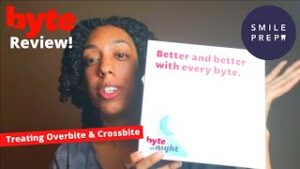
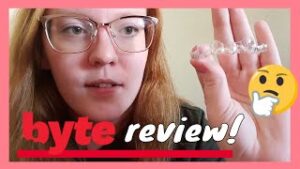

Invisalign Customer Reviews
Invisalign patients are typically satisfied with their results and impressed by how their aligners can correct even severe issues. They like the personal touch of regular office visits, even though they can be time-consuming.
Patients often noted how expensive Invisalign can be, although many thought it was worth the price for the quality of care they received. Some customers said the attachments could feel rough or sharp, irritating their cheeks and tongue. However, after a few days, that discomfort typically subsided.
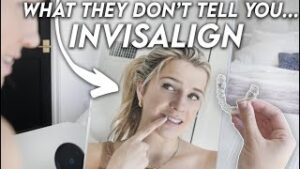

Which Should You Choose?
We think both companies offer quality clear aligner treatments. Neither one is clearly or inherently better than the other. Rather, each one has its own strengths and each excels in different circumstances. So, your decision should be based on your unique condition, goals, and expectations.
Who Should Choose Byte?
Anyone who wants to correct a mild-to-moderate misalignment with a treatment that incorporates innovative technology and solid customer service should consider Byte.
Who Should Choose Invisalign?
To correct a more severe condition, or if you’re more comfortable receiving one-on-one care from a dentist/orthodontist, Invisalign is an ideal choice.
We Recommend Byte For Most Readers
Unless you have a severe misalignment or prefer in-person care, we recommend Byte over Invisalign, since they offer a significantly lower price point and the convenience of at-home treatment.
Frequently Asked Questions
How do I get started with Invisalign or Byte?
You can’t begin Invisalign treatment without first visiting your dentist or orthodontist. They will assess your smile, take impressions or scans of your teeth, and get the ball rolling. Byte, however, cuts out in-person visits altogether, so you need to kick start the process from home. To start your Byte treatment, purchase and complete an impression kit, which lets you create molds of your teeth.
How much do Invisalign and Byte cost?
Invisalign’s prices can vary based on numerous factors, like your condition, your location, and your dentist’s rates. But most people end up paying somewhere between $3,000 and $8,000. Byte has a flat rate of $2,099 (or $2,499 for Byte At-Night), which includes your full aligner treatment, free whitening foam, and one set of aftercare retainers.
What are Invisalign and Byte customers saying?
Since Invisalign treatment can vary based on the dentist or orthodontist who provides it, it’s hard to define an “average” customer experience, although a vast majority of customers are pleased with their results (but not, necessarily, the price). Byte’s customers give high praise to the company’s personalized customer support and consistent results. Some have expressed frustration with delayed response times, but most customers are happy with their experience.
How long do Invisalign and Byte take?
Your Invisalign or Byte timeline depends on the severity of your condition. But Invisalign treatment often takes 12–18 months while Byte says their average treatment plan lasts 4–5. That’s in part because in-office aligners generally treat more complex cases, which take longer to correct.
What’s the difference between Invisalign and Byte?
Both companies provide clear aligner treatment that gradually shifts your teeth to a new position. Invisalign is an in-office treatment, which means that it’s administered by a dentist or orthodontist and typically requires office visits every 4–10 weeks.
Byte, however, lets you administer treatment entirely at home. Your treatment is still designed by dentists and orthodontists, but you don’t need to make office visits for regular check-ins.
Can I wear my aligners only at night?
Only if you choose Byte. Invisalign says that the best way to move teeth is by wearing your aligners for 22+ hours per day. However, Byte has developed a nighttime-only treatment (called Byte At-Night) that only requires ten hours of overnight wear. It costs a bit more and takes slightly longer, but if you don’t want to wear your aligners to work, school, etc. it could be a great option. SmileDirectClub, AlignerCo, and NewSmile also have nighttime-only treatment plans.
What conditions can Invisalign and Byte treat?
Invisalign can treat almost any dental or jaw misalignment because it can incorporate supplemental attachments for more power and intricacy. Because Byte doesn’t have the same in-person oversight and available attachments, it’s restricted to treating mild and moderate cases of crowding and spacing.
What is the cheapest clear aligner company?
AlignerCo. At just $995, their price beats every competitor by a few hundred dollars, and sometimes they run promotions that drop it even lower. And if you can’t pay that upfront, you can jump on a financing plan, regardless of your credit score. Check out our complete AlignerCo review for more info, or find other great-value options in our guide to the most affordable home aligners.
Does insurance cover clear aligners?
Sometimes. Most insurance providers don’t cover home aligner treatment, although some might if you have orthodontic benefits. They’re more likely to cover an in-office treatment like Invisalign. The only way to find out for sure is to contact your provider and ask.
Are home aligners safe?
At-home clear aligner treatment plans are always designed and/or approved by a licensed dentist or orthodontist — as long as you’re buying from a legitimate clear aligner service.
The main concern regarding the safety of fully-remote clear aligner treatment is the lack of face-to-face care. Since you won’t be seeing a dentist in-person during treatment, you won’t receive the same level of support that you’d get with traditional in-office aligners like Invisalign or ClearCorrect. That said, a recent NIH-funded survey found the majority of at-home aligner customers were satisfied with their results, and only 6.6% experienced side effects necessitating a visit to their local dentist.
Read our guide to safe home teeth straightening treatment for more information.
Do clear aligners hurt?
When you switch to a new aligner set, you might experience some discomfort for the first day or two, but after that, you’ll hardly notice them.
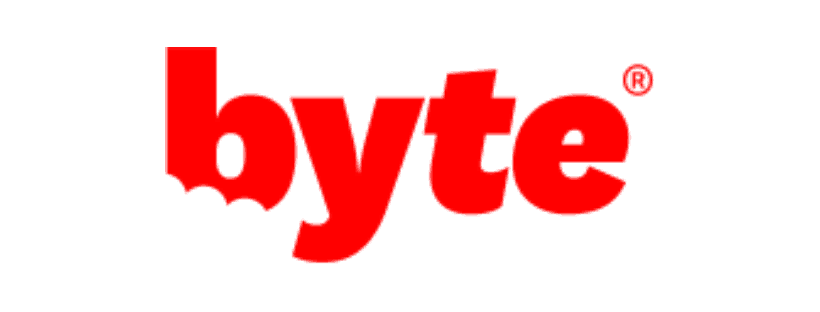
Join The Discussion: